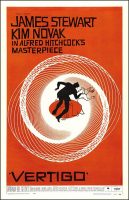Tagline: A Hitchcock thriller. You should see it from the beginning!
Vertigo (1958) is one of Alfred Hitchcock’s most powerful, deep, and stunningly beautiful films (in widescreen 70 mm VistaVision) – it is a film noir that functions on multiple levels. At the time of the film’s release, it was not a box-office hit, but has since been regarded as one of the greatest films ever made. The work is a mesmerizing romantic suspense/thriller about a macabre, doomed romance – a desperate love for an illusion.
It is an intense psychological study of a desperate, insecure man’s twisted psyche (necrophilia) and loss of equilibrium. It follows the troubled man’s obsessive search to end his vertigo (and deaths that result from his ‘falling in love’ affliction) and becomes a masterful study of romantic longing, identity, voyeurism, treachery and death, female victimization and degrading manipulation, the feminine “ideal,” and fatal sexual obsession for a cool-blonde heroine. Hitchcock was noted for films with voyeuristic themes, and this one could be construed as part of a ‘trilogy’ of films with that preoccupation:
Rear Window (1954)
Vertigo (1958)
Psycho (1960)
The film’s screenplay, written by Alec Coppel and Samuel Taylor, was based upon the 1954 mystery novel D’Entre les Morts (literally meaning “From Among the Dead” or “Between Deaths”) by Pierre Boileau and Thomas Narcejac. Boileau and Narcejac were also the authors of the story for French director Henri-Georges Clouzot’s Les Diabolique (1955) starring Simone Signoret. The film’s theme of play-acting and/or remaking a woman by male domination was also echoed in Greek legend, and in George Bernard Shaw’s Pygmalion (and My Fair Lady (1964)). The film spawned clones with similar themes, such as Brian DePalma’s Obsession (1976), and director Kenneth Branagh’s Dead Again (1991).
Vertigo is a 1958 American film noir psychological thriller film directed and produced by Alfred Hitchcock. The story was based on the 1954 novel D’entre les morts (From Among the Dead) by Boileau-Narcejac. The screenplay was written by Alec Coppel and Samuel A. Taylor.
The film stars James Stewart as former police detective John “Scottie” Ferguson. Scottie is forced into early retirement because an incident in the line of duty has caused him to develop acrophobia (an extreme fear of heights) and vertigo (a false sense of rotational movement). Scottie is hired by an acquaintance, Gavin Elster, as a private investigator to follow Gavin’s wife Madeleine (Kim Novak), who is behaving strangely.
The film was shot on location in San Francisco, California, and at Paramount Studios in Hollywood. It is the first film to use the dolly zoom, an in-camera effect that distorts perspective to create disorientation, to convey Scottie’s acrophobia. As a result of its use in this film, the effect is often referred to as “the Vertigo effect”.
Vertigo (1958)
Directed by: Alfred Hitchcock
Starring: James Stewart, Kim Novak, Barbara Bel Geddes, Tom Helmore, Henry Jones, Raymond Bailey, Ellen Corby, Konstantin Shayne, Lee Patrick, David Ahdar, Isabel Analla, Margaret Bacon
Screenplay by: Alec Coppel, Samuel Taylor
Cinematography by: Robert Burks
Film Editing by: George Tomasini
Costume Design by: Edith Head
Set Decoration by: Sam Comer, Frank R. McKelvy
Art Direction by: Henry Bumstead, Hal Pereira
Music by: Bernard Herrmann
Distributed by: Paramount Pictures
Release Date: May 9, 1958
Views: 277

